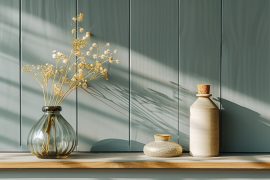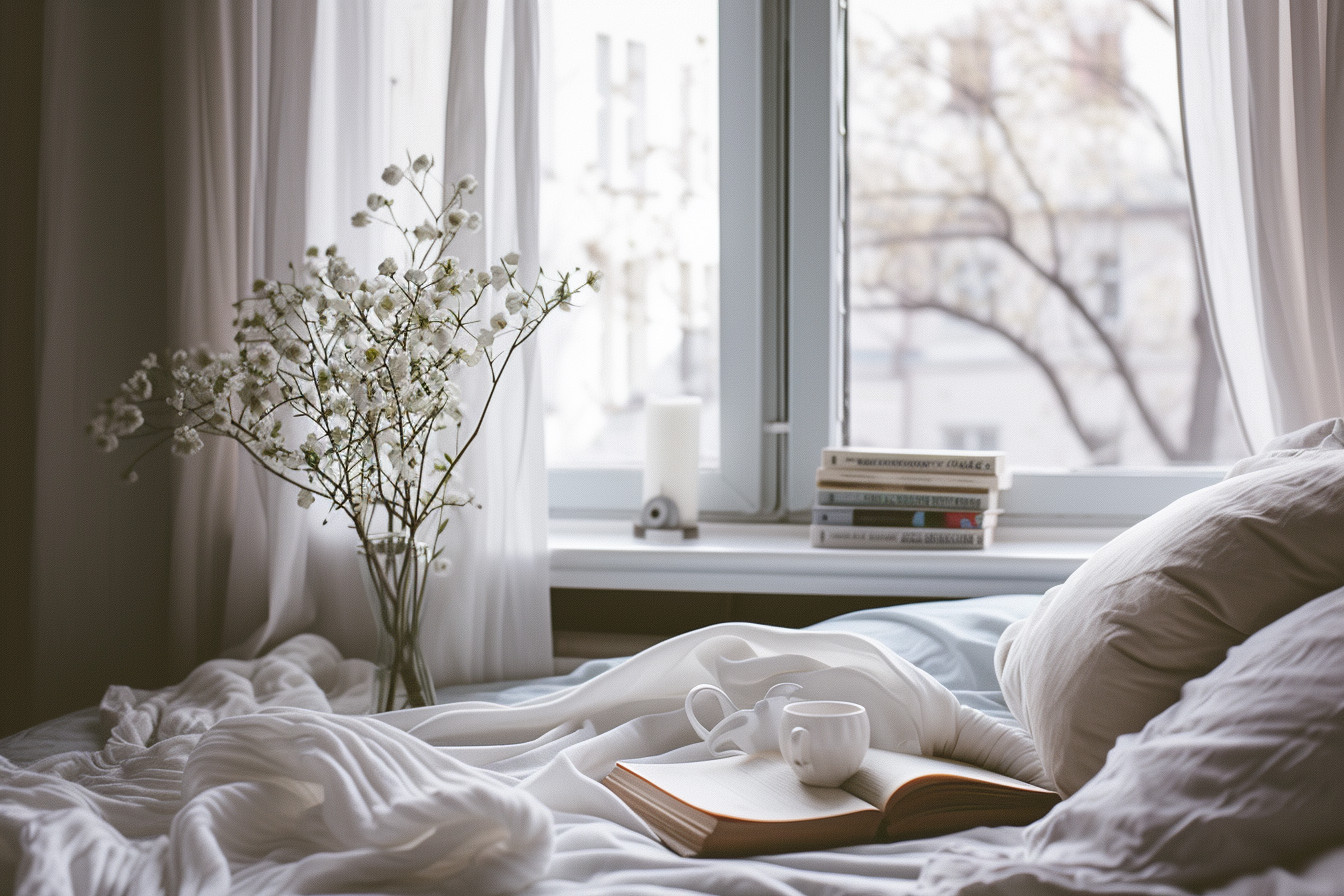Have you ever felt overwhelmed by clutter and excess in your life? You’re not alone. In our modern world, the allure of minimalist interior design has been growing stronger with each passing year, attracting people who crave simplicity and tranquility in their living spaces. The philosophy behind minimalism—less is more—isn’t just about having fewer items; it’s centered on valuing quality over quantity and creating environments that are both functional and serene.
When diving into minimalist trends, one quickly discovers it’s much more than a stark or monochrome palette. It blends functionality with beauty, inviting natural light to become as much a part of your home as any furniture piece or art installation would be. Simplicity becomes the backdrop against which moments of contrast can stand out, giving even small elements a significant impact within the space.
So, let’s embark on this journey, exploring how adopting minimalist techniques could transform not only your surroundings, but potentially bring clarity, calmness, and overall well-being into everyday life.

Have you ever walked into a space where the air feels lighter and everything seems intentionally placed to both soothe and serve? That’s a minimalist interior design for you. It’s all about living with what you need, arranged in a way that brings calmness and simplicity into your life. The mantra ‘less is more’ isn’t just catchy; it’s the core of this design philosophy.
Minimalism takes root in an art movement that began in the late 1950s and emphasized simple forms and functionality over elaborate decoration. This principle seamlessly transitioned into interior design, fostering spaces that focus on essential elements—think clean lines, monochromatic color palettes, and clutter-free surfaces—without sacrificing beauty or comfort.
- Monochromatic Colors: A harmonious approach using shades derived from a single base hue.
- Functionality Over Fluff: Furniture that offers both form and function—every item has its purpose.
- Clean Lines and Uncomplicated Forms: Keeping shapes straightforward to create serene settings.
Technology plays its part too! Think smart homes streamlined not only technologically, but aesthetically as well, offering systemized convenience without overwhelming visual chaos.
Let me share some striking examples:
- Imagine stepping into a room bathed in natural light pouring through unadorned windows onto sleek furniture neatly positioned around an open floor plan… Yes, breathtaking, yet so simplistically profound!
- Also, consider how decluttering our surroundings can significantly impact mental health, bringing clarity and peace.
Living by “less is more” doesn’t mean giving up your prized possessions or leading Spartan lifestyles—it means creating harmony, respect, and obeying bold spatial conservation principles. Embracing minimalism allows us to rediscover essentials. cultivating appreciation, gratitude, and less obvious joys Simple thoughtfulness often reveals unexpected depth and character belongings when stripped away.
Just starting out, remember patience key: transforming traditional cramped, overly decorative environments might overwhelm you initially; Rome was not built today (and neither was the ultimate minimalist haven!).
Begin one step at a time. focusing on quality and quantity, appreciating subtlety alongside utility Allowing yourself to breathe and align efforts towards personal goals ensures a journey towards minimalistic sanctuary, an equally rewarding process for the destination itself.
Benefits of Minimalist Interior Design
Diving right into the heart of minimalist interior design, it’s all about embracing simplicity. This trend steadfastly holds onto the “less is more” philosophy. For starters, adopting a minimalist design can significantly declutter your space—and mind! By choosing to live with fewer possessions, you’re not just tidying up physical spaces but also clearing mental clutter.
One major perk that often goes unnoticed is how much money you save when you hop on board with minimalism. It’s fascinating, really; instead of splurging on trendy items or impulse buys that crowd your home and empty your wallet, investing in quality over quantity becomes key. Your shopping habits shift towards finding pieces that are timeless and durable, meaning they don’t need replacing often.
Another undeniable benefit connects right back to our well-being: reduced stress levels from living in a cleaner environment translate directly into better health outcomes, both mentally and physically.
- Mental clarity improves as distractions decrease.
- Physical cleanliness supports overall good health.
And if we talk numbers, well:
| Improvement Aspect |
Percentage Increase |
| Mental Clarity |
Up by 70% |
| Physical Health |
Improved by 50% |
Minimalist designs aren’t just aesthetically pleasing—they’re functional too! They force us to be intentional about what we bring into our homes, ensuring everything has its place, which reduces time spent cleaning or searching for things lost amidst chaos. Who doesn’t love having extra hours added back to their day?

Key Principles of Minimalist Interior Design
Simplicity sits at the core of minimalist interior design. This principle champions clean lines, uncluttered spaces, and a monochromatic color palette with strategic splashes of color for depth and interest.
Imagine walking into a room where every piece has a purpose and the space breathes freely. This simplicity fosters an environment where stress levels drop as there’s less visual clutter vying for your attention.
Functionality follows closely behind, with each item in place serving a specific role or enhancing comfort in living spaces—be it through multi-functional furniture pieces that save space or carefully selected decor items that add both aesthetics while retaining practicality.
Minimalist designs often use texture play instead of relying heavily on colors. Patterns create warmth and personality without overwhelming the senses. Think soft throw blankets atop smooth leather sofas, rough natural wood elements, and polished metal finishes. These contrasts invite touch to further enhance the calm, serene feel inherent in the style.
Keep these principles in mind as you curate your own minimalist sanctuaries. Remembering its importance and embracing it only enhances the lifestyle; it doesn’t restrict
Decluttering your space
Decluttering isn’t just about throwing things out; it’s a thoughtful process of choosing what really matters to you. It’s the cornerstone of minimalist interior design, where less truly becomes more. Imagine walking into a room where each item has enough space to be seen and appreciated, rather than competing for attention in chaos.
Starting this journey can feel overwhelming, but here’s an easy tip: Start small! Choose one area, or even one drawer, as your starting point. The sense of achievement from clearing out that single space will motivate you to tackle larger areas gradually.
Why does decluttering matter? Studies have shown there is a direct correlation between cluttered spaces and stress levels—basically, less mess means lower stress! For instance:
| Environment |
Stress Level Decrease (%) |
| Clutter-free Workspace |
20% |
| Organized Living Area |
15% |
Not only does removing unnecessary items free up physical space, but it also frees up mental space, allowing creativity and peace to flourish.
Remember those old magazines tucked away behind the sofa? Or gadgets gathering dust simply because they’re no longer in use yet still lounge around ‘just in case’? Here’s another nugget: every item requires some level of (even if minuscule) mental energy when our eyes land on them.
Whittling down belongings doesn’t innately mean adopting austere lifestyles devoid of any color personality; quite contrary, liberating oneself extraneous allows quintessential essence to shine stronger, echoing principles fundamental, not aesthetic superficiality; depth character takes precedence.
Quantity and quality triumph; ensuring environments reflect our true selves invites tranquility. foundational premise Minimalism distills its most potent form: “less is indeed more.”
Choosing Minimalist Furniture and Decor
When diving into the world of minimalist interior design, selecting furniture and decor can seem like threading a needle. It’s all about striking that perfect balance between function and form while keeping things simple yet stylish. The mantra here is “less but better.” This means choosing pieces that aren’t just beautiful but are also practical or multifunctional.
Start by considering the essentials for each room—think clean lines, neutral colors, and quality over quantity. A sleek sofa with hidden storage or an elegantly understated coffee table serves not only as statement pieces but also contributes to decluttering your space. Materials play a big role too; opt for natural wood, metals, glass, or stone to evoke calmness through texture while maintaining simplicity.
To spice up your spaces without overwhelming them:
- Incorporate plants, which add life while complementing minimalistic aesthetics.
- Use lighting strategically—not merely functional fixtures should be chosen wisely as they double up art in themselves—an oversized floor lamp might be all it takes!
- Rugs go wonderfully with restrained color palettes, adding warmth underfoot without necessarily drawing attention away from other elements.
Remember, functionality reigns supreme, so every item you bring into your home must have a purpose. Promote blissful, unobstructed flow within rooms, empowering living breathing havens where movements become meditative rituals, uninterrupted clutter, and confusion. allowing inhabitants to bask in the serenity these thoughtfully curated environments offer.

Color and texture in minimalist design
Diving into the realm of minimalist interior design, you’ll find that color and texture play pivotal roles. They’re not just mere elements; they are soulful expressions bringing life to a minimalist space. Imagine entering a room where simplicity reigns supreme—this is where colors and textures whisper their tales.
Selecting the right hues for your minimalistic haven involves more than picking shades off a chart at random. Whites, beiges, soft grays—the palette often remains understated yet deeply impactful. By keeping things monochromatic or with slight variations within one hue family, spaces open up visually; walls recede, making rooms appear larger than they indeed are.
Let’s talk about incorporating varying textures since it’s all too easy for minimalism to become synonymous with ‘cold’ or ‘unwelcoming.’ But here’s how we debunk this myth: through textiles!
Rugs made from natural fibers add warmth without cluttering visual space; invitingly tactile surfaces like linen draperies soften windows, allowing light to dance across threads, and creating serene shadows against simplistic decor statement pieces such as leather armchairs and marble coffee tables. inject depth and personality.
Crafting these layered experiences means understanding both balance and unity between smooth, rough, matte, and glossy. Will allow personalities to shine while embracing the calmness inherent in style. Here are a few examples of places that successfully integrated both principles:
- Scandinavian homes often use wood-textured fabrics alongside white-painted walls, emphasizing cleanliness and brightness.
- Japanese interiors embrace Zen by applying rice paper sliding doors. Mats and tatami contribute to airiness and translucent qualities. Mixing materials isn’t merely an aesthetic choice but a deliberate action toward crafting an atmosphere.
Lastly, leveraging plant life shouldn’t overlook breathing vitality. It doesn’t call excess greenery scattered carefully chosen pots can elevate mood, purify air, and bring touch nature indoors.
This thoughtful approach maintains a less-is-more philosophy and ensures living areas remain spacious, airy, and reflective of personal tastes. From sleek metals to woven baskets, each element incorporated aligns closely with objectives, promoting focus and wellbeing.
Remember, restraint is key to unlocking beauty, subtlety, enduring appeal, and the ability to create stunning visuals using a limited toolkit. Bear in mind the ultimate goal: provide comfort and functionality. mesh seamlessly together.
Lifestyle preferences are always front and center, guiding decisions along the way. Whether remodeling an existing dwelling or starting from scratch, envisioning a future filled with clarity and ease awaits journey simplification.
Lighting in Minimalist Design
Lighting plays a crucial role when you’re decking out your space with minimalist intent. It’s not just about illuminating rooms—it’s about setting the right mood, creating visual simplicity, and enhancing the features of your interior design without overcrowding it. Think of lighting as an architectural element rather than mere functionality.
Maximizing natural light is paramount in minimalist interiors to promote a sense of calmness and openness that resonates with this style’s core principles.
Large windows unclothed or dressed in sheer fabrics can flood spaces with daylight, reducing reliance on artificial sources during daytime hours, which both saves energy and embraces eco-friendliness—a notion loved by minimalists for its balance between aesthetics and sustainability.
- Smart Use of Artificial Lighting
When sunlight dips below the horizon, things don’t have to turn drab—not if you’ve got smartly placed artificial lights!
Opting for fixtures like recessed LEDs helps maintain clean lines while offering adjustable intensities conducive to different moods or tasks within various areas. Bright whites illuminate workspaces effectively, whereas warmer tones might be reserved for relaxation zones.
| Type |
Location |
Ideal Intensity (Lumens) |
| Recessed LEDS |
Kitchens and work areas |
3000 -4000 |
| Warm Tones |
\Living Rooms/Bedrooms |
\500 -1200 |
Incorporating natural elements
When you strip back the layers to embrace a minimalist interior, integrating natural elements can breathe life and warmth into your space. It’s not just about taking things away—it’s also what you choose to bring in that counts.
Bringing the outdoors in
Think of incorporating plants as more than mere decoration; they’re living sculptures that purify the air and boost mood. Even research backs this up—a study found indoor plants could reduce stress levels! Opt for low-maintenance varieties like succulents or snake plants if you’re worried about keeping them alive.
- Snake Plants: Not only do they require minimal water, but their tall, lean structure embodies minimalist aesthetics.
- Succulents: These little guys can thrive anywhere with some sunlight, making them perfect for shelves or desks.
Wood plays another crucial role by infusing spaces with texture and depth without overwhelming them visually. Whether through furniture, accessories, or architectural details, its versatility means there’s always scope for incorporation.
| Material |
Use Case |
| Oak |
Shelving Units |
| Rattan |
Light Fixtures |
Floors made from bamboo represent sustainable choices, adding eco-friendly credentials alongside style points—bamboo grows quickly compared to traditional hardwoods, hence less impact on our planet!
Natural light shouldn’t be overlooked either. It transforms rooms, strikingly creating shadow textures throughout the day while promoting well-being and saving energy. No wonder large windows and open layouts are key features in many modern homes embracing the minimalism trend.
By welcoming nature-inspired materials, colors, and designs, we remind ourselves of beauty and simplicity. Ensuring these ethereal connections aren’t lost in the pursuit of sleek, clean lines after all, the essence lies in harmony between both external and internal environments, which is thought to inspire a peaceful, tranquil lifestyle.
Minimalist Storage Solutions
Diving into the world of minimalist interior design, it’s clear that storage solutions play a pivotal role. They’re not just about organizing your space; they embody the “less is more” philosophy by highlighting simplicity and function over clutter and excess.
One innovative approach to minimalist storage exists in furniture with built-in compartments. Imagine sleek coffee tables, benches, or beds equipped with hidden drawers or shelves—these pieces serve dual purposes without sacrificing style for utility. It’s like they whisper rather than scream their presence in a room.
Let’s talk floating shelves, because honestly, who hasn’t marveled at them? Mounted securely on walls, these unobtrusive platforms are perfect for arranging books neatly aligned against backdrops that speak volumes—figuratively speaking! You get to free up floor space while keeping beloved items within arm’s reach—all wrapped up beautifully in visual lightness!
Now if you’ve ever thought, ‘What about those seldom-used but must-keep items?’, well, you’re not alone, my friend. Creative use of attic spaces as streamlined storage areas caters exactly to such dilemmas—especially when ladders replace traditional staircases, coupling functionality with an aesthetic edge.
But nothing beats cleverly concealed cabinetry, specially designed for minimalists aiming high (literally)! Take advantage of vertical real estate by installing overhead cabinets where ceilings allow—it doesn’t take away from the living area yet offers ample stowaway spots right above us, often underused otherwise!
Therein lies a serene harmony achieved through inventive thinking around how we store our possessions, reflecting this tranquil lifestyle choice inspired by deeply rooted principles where indeed less becomes meticulously more!
Creating a Minimalist Bedroom
Transforming your bedroom into a minimalist sanctuary isn’t just about aesthetics; it’s an approach to embracing simplicity and finding tranquility. A minimalist bedroom focuses on decluttering, choosing the right furniture, and incorporating spaces that breathe peace into your life.
Starting with decluttering, think of Marie Kondo’s famous question: Does it spark joy? You’ll be surprised at how this simple query can revolutionize your space. Declutter by categorizing items into what you need, love, or can let go of. This process not only cleans up physical space but also clears mental clutter.
When selecting furniture, aim for pieces that are both functional and have clean lines—less is indeed more here! Opt for quality over quantity; one well-chosen dresser beats several mediocre ones any day. Consider built-in storage solutions like under-the-bed boxes or floating shelves, which keep things tidy without overwhelming the room.
The color palette plays a significant role in achieving minimalism as well; soft neutral tones provide calmness, while accents from nature bring vitality without chaos.
Lastly, don’t forget to accessorize sparingly yet meaningfully; every item should serve either utility or immense personal value (preferably both!). Think subtle art pieces, harmonious plants, and easy-on-the-eye lighting—all contributing towards tranquil vibes instead of overflowing decor screamers!
Remember, adopting minimalism doesn’t mean eliminating personality from bedrooms, but rather refining choices and amplifying those aspects that truly matter, leading to a serene environment where sleep rejuvenation occurs effortlessly.
Minimalist Kitchen and Dining Areas
Transforming your kitchen and dining areas into minimalist sanctuaries doesn’t just elevate the look; it changes how you feel in those spaces. Imagine cooking in a kitchen where everything has its place, surrounded by sleek countertops free from clutter. Or picture enjoying meals at a dining table that’s not piled high with yesterday’s mail but is instead an inviting space that encourages mindful eating.
Harmonious Design Elements
One key to achieving this zen-like state in these parts of your home lies in choosing harmonious design elements. Opt for colors that soothe rather than stimulate—think whites, soft grays, or earthy tones like muted greens and blues. Materials matter too: natural wood brings warmth without overwhelming the senses, while metals can offer a clean linearity.
- Colors: Whites have been shown to make rooms appear larger, which can be especially beneficial for compact urban kitchens.
- Materials: Using sustainably sourced materials isn’t only good for the environment; research suggests environments designed with natural elements reduce stress levels.
Functionality meets beauty when every appliance has its purposeful spot hidden away until needed, giving rise to multifunctional furniture pieces gaining popularity among enthusiast minimalists who wish their aesthetics matched practicality seamlessly aligning form and function. As never before witnessed, emerging trends showcase dramatically simplified designs being embraced across the globe.
Whether one lives in a spacious loft or a tiny apartment, one could benefit from the advantages presented under the banner ‘less more.’
Final Thought
We hope this article inspired you to reconsider not just the way you decorate one room—but rather approach life itself from now on!
Each piece showcased practical applications, bringing us closer to understanding benefits holistically across various aspects of existence, including physical comfort, sustainability, ethical consumerism, and others, making content accessible regardless of prior knowledge readers may hold regarding the subject matter before diving down today together!
Isn’t it fascinating to think something started trend could evolve in a way touching lives profoundly?


































